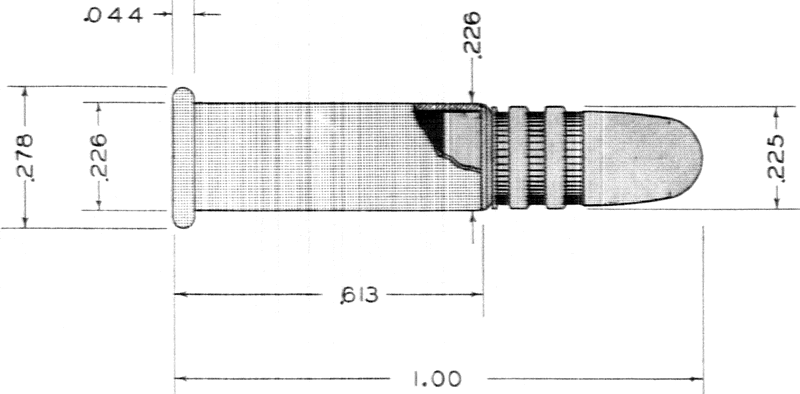
This page is still under construction, but we hope that there is enough information already here to make your visit worthwhile. - Included, amongst other subjects, are
.22 RF Cartridges * Morris CF Cartridges * Flobert RF Cartridge
See also an excerpt on Miniature Rifle Ammunition - Military specification .22-inch Mk.1 (from the Textbook of Smallarms 1929)
For the uninitiated, we ought not to take for granted the automatic understanding
of the many abbreviations used in firearm and cartridge terminology.
There is therefore justification for defining in brief some relevant terms.
Those relatively low calibres usually prefixed with a decimal point represent the dimension
of the diameter of the bore of a firearm in inches or millimetres to two or three decimal places.
We are here discussing the 'rifled' barrel, the term given to a barrel with spiral grooves machined into the inner surface of its bore
(which spin the bullet for greater stability and accuracy).
The measurement used, for the bore dimension, is that of the diameter of the smooth bore BEFORE the grooves are machined.
The depth of these grooves in a modern small-bore rifle may be little more than three-thousands of an inch.
The upper surface of what now appear to be raised spiral lines in the bore are called the "lands",
and it is the diameter between these that dictates the calibre of the firearm.
You will often hear rifles and pistols described as 'weapons'. This is an accurate description of a military firearm,
but not true of any firearm, be it rifle, pistol or other, that is specifically designed for target shooting.
Hunting and field sporting arms may arguably fall within the weapon category - the quarry have been known to fight back
- but to call a target rifle a 'weapon' is to voice a misnomer.
"RF" stands for Rim-Fire, which type of cartridge has the detonating primer material
spun into the rim or flanged head of the cartridge-case during manufacture.
The rim is struck by a firing-pin necessarily slightly offset from the centre-line of the bore,
firing the cartridge when the trigger is pulled.
"CF" stands for Centre-Fire, which cartridge usually has the the priming material held separately
in a small soft metal circular percussion-cap which is pressed into a recess in the centre of the head of the cartridge-case.
Thus the firing-pin is central to the axis of the bore.
The most commonly known and used miniature calibre rimfire cartridge is the "Twenty-two",
as it is traditionally described in North American parlance.
This round was itself an American invention which remains in world-wide use some 150 years after its first appearance.
With a heritage dating back to ca., 1845 and related to the "BB" cap (Bulleted-Breech - shown further down this page)
invented in 9mm rim-fire configuration, with a slightly bulged tapered rim, by Nicolas Flobert, a Swiss then residing in Belgium.
This cartridge was modified and produced in 6mm calibre, the European equivalent of the .22 inch cartridge.
The first .22 Short rim-fire cartridge, with the rim in virtually its present form and a powder charge between the primer and bullet,
has been accredited to Daniel Wesson, of Smith & Wesson, in 1856, with public sales commencing about two years after.*
This cartridge's development was initially for the company's pistols, and, arguably,
one of the earliest long-arms to use the round was a form of Volcanic carbine
contemporarily marketed by the New Haven Arms Co, owned by Oliver Winchester.
This was not the well known .38 or .41 calibre one-piece "Volcanic Carbine",
but in truth a long-barrelled pistol - of a type now dear to U.K. target shooters -- and with a removable butt-stock,
which arm was most usually chambered in calibres above .30, but modified for the .22RF cartridge.
Unsurprisingly, over the following three or four years, production of many suitably chambered rifles was to commence elsewhere and,
in common with the European production of Flobert based rifles, of which the Model 2 rifle may perhaps lay claim
tohave been leading the race to get a .22 rim-fire genre rifle into production.
Smith & Wesson did make the first lever-action predecessors of the Winchester under-lever rifles,
but these were chambered for the very poorly designed "rocket ball" cartridge
that consisted of a hollow base bullet containing just primer material.
The development and popularity of these miniature-calibre rim-fire rifles
and pistols was set for a century and more of development and expansion into field and target sports for the masses.
In this, one should not overlook the considerable subsequent utilisation of such small-bore arms for military training.
In fact, .22 rim-fire cartridges were, in the 20th. Century, even to find occasional employment in combat operations with various "special forces"
Having evolved over these many years from black-powder to smokeless propellant,
.22" rimfire cartridges have been manufactured in many and varied configurations for a multiplicity of purposes and firearm designs.
This evolution has, latter-day, resulted in cartridges being available in three more usual forms, namely:
1) The "Short" cartridge
2) The "Long" cartridge
3) The "Long Rifle" cartridge

Diagram from "Rimfire Rifleman" 1947 - see Bibliography
The "Long" and "Long Rifle" cartridges utilised the same case - 0.613 inches in length,
but the "Long" cartridge was fitted with the smaller bullet of the "Short" cartridge,
resulting in its intermediate overall length of 0.887". The "Short" cartridge is 0.695" overall.
The "Long" has latterly fallen into disuse, and the "Short" is manufactured in quantities a mere fraction of what was once the case.
One even longer round was introduced ca. 1880 for use in many American manufacturers' rifles and pistols but,
although more powerful than the Long Rifle cartridge, with the same 40 grain bullet and initially a 6 grain black-powder load,
this "Extra Long" ammunition proved less accurate, and was no longer marketed by the mid 1930s.
There have also been other shorter than Short "Gallery" rounds in years past, oft fired on commercial or showmen's gallery ranges -
- Clacton Pier still had such a public shooting gallery until the mid 1960s - where any holidaymaker would be able to enjoy 'plinking'
at a variety of targets with the ubiquitous Winchester pump-action gallery rifles.
But, without doubt, the most accurate and sensibly configured Long Rifle cartridge has won the day,
with world production and consumption now in multi-million figures annually.
Once referred to as ".220 inch calibre", and often found so marked on many classic small-bore rifles -
- particularly of Birmingham Small Arms Company manufacture -
- the more usual modern marking of such small-calibre rifles is ".22RF" the designation that it is of rimfire calibre,
followed by "Short" or "Short Cartridge", "Long" or "Long Rifle",
to indicate the particular length of cartridge for which the rifle (or indeed pistol) is chambered.
This page will illustrate a number of both familiar and unusual cartridges, as well as initially give a brief insight into manufacture.
We only briefly here mention the .22 Hornet CF cartridge, which can no more be described as a 'miniature calibre cartridge'
than the current military .223" round, certainly in the terms of our accepted definition of the phrase from an historic point of view.
The .22RF Long Rifle cartridge has, however, been the mainstay of small-bore or 'miniature-calibre' shooting for more than a century, and merits deeper discussion.
It is an indisputable fact that the notable improvements in accuracy of small-bore rifles
since the early Twentieth Century are largely due to the advancement of cartridge technology.
This involved advances in almost every respect, including the metallic materials used,
the propellants, priming compounds, and the finer tolerances imbued in modern machining and manufacture.
The thoroughness and effectiveness of current quality control methods are additional proven critical factors.
Consistent accuracy on the range can only be achieved with consistent accuracy in manufacture.
In saying this, we have no wish to demean the efforts of the rifle manufacturers, whose own technological advances have been considerable.
They have more than met the needs of their client base, and been equally instrumental
in the successes of the shooters for whom their products have been designed and marketed.
The fact remains, though, that some 'miniature' rifles made a hundred years ago,
with barrels that may in that time have fired many thousands of rounds,
can still be found capable of grouping more tightly than a modern rifle would be able to achieve with early ammunition. Q.E.D.
We are about to précis the complicated rimfire manufacturing procedure in use today,
offering one important home-grown and venerable company as the example.
We regret that we do not have space to do justice to the subject,
let alone describe every one of the plethora of technologically advanced machines and processes nowadays involved.
Suffice it to say that the U.K.'s own Eley company not only manufacture the ammunition,
but design and build much of their own machinery as well as marketing this equipment internationally.
N.B. Please be aware that the following section is not an advertising piece.
You are visiting a genuinely non-commercial website.
However, we are recording British small-bore rifle history, and felt strongly that an element of the world renowned success of U.K.,
target rifle manufacturers is also attributable to, and reflected in,
the years of research and development undertaken by our ammunition manufacturers.
We make no apology for blowing Great Britain's own trumpet.
Most production of the .22 rimfire cartridge in the U.K. has been undertaken by the Eley-Kynoch company,
Eley being latterly part of ICI (Imperial Chemical Industries), but the Kynoch name was bought-up by a private company
currently manufacturing specialist Express ammunition near Mildenhall in Suffolk.
In its original guise, Kynoch introduced their first .22 target rifle ammunition in 1909,
when it was first advertised in the "Rifleman", the journal of the Society of Miniature Rifle Clubs.
All but a hundred years on, Eley still manufacture the cartridge in multiple forms, and export to all corners of the World.
A visit to the present-day factory will illustrate how the basic principles of production have, in some ways, changed very little over the years.
Nevertheless, manufacture has without doubt become a significantly more sophisticated science in recent decades.
Eley .22 cartridge production starts with a reel of brass sheet about 4¼ inches wide and two feet in diameter.
This is fed through an indexing press with a tool die set which 'progressively 'draws' the cartridge-case blank.
This can be seen in a section cut from the length of sheet whilst the press has been halted.

This sample is rather old and no longer perfectly flat, but nevertheless depicts the process clearly.
Above, from right to left, the disc that will form the case is initially punched almost flush to the surface of the sheet;
then a series of dies, of increasing depth and decreasing diameter, force the case into its final shape in a succession of operations.
The image below shows the progression from the finished end,
at the point where the fully drawn cases are punched clear of the sheet into a collecting receptacle.

Below, left to right, are shown the results of each of the following processes.
The freshly formed cases (1) have the rim formed at the 'head' of the case (2) (note that the 'head' of the case is here at the bottom)
with dies carrying the 'head stamp' pressing into the head a logo or initial to identify the manufacturer.
The case is (1) trimmed to the correct length and cleaned; (2) in preparation for priming;
(3) injected with the priming compound (showing as pale red inside the case);
(4) is spun into the narrow space remaining between the two thicknesses of brass forming the rim.
It is this primer which, when rapidly compressed between the sides of the rim,
itself clamped firmly between the accommodating recess in the chamber of the rifle breech and the rifle's bolt-head,
is detonated when the rim is struck by the firing pin driven through the offset striker hole in the bolt-head.
This in turn explodes the propellant powder within the case,
the rapidly increasing pressure from which forces the bullet into the rifling of the barrel,
sending it on its way to the target at close to the speed of sound.
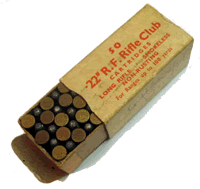



![]()
![]()

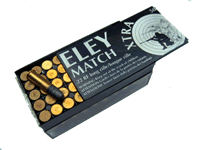
1............2............3.........4....''.....5........6........................
The bullets are formed in two ways depending upon the purpose for which they are intended in the finished cartridge.
The most economical method is utilised for the basic and cheaper "Club" ammunition,
with the bullet being formed from a slug (5); Tenex, the top grade of cartridge, uses a bullet (6) formed from an extruded lead alloy wire.
A lead billet of 5 inches diameter, and just over a foot long, is fitted into a hydraulic press and forced
by a massive ram at extremely high pressure through an extrusion die.
The bullets are swaged from this lead wire in precision dies.
The method maintains constant density of the bullet material and precludes voids.
The manufacture of Tenex ammunition takes place on a separate production line,
and the finished article is put through the most thorough regime of inspection and testing.
Dimensions and weights of all components are checked after each individual operation,
of which there are dozens, before the end product is packed and stored ready for despatch.
Batches are checked for pressure/muzzle velocity and accuracy on the company's underground 50 metre testing range,
to where shooters competing at higher levels may bring their rifles and themselves test batches of ammunition for best suitability in their own rifle barrel.
Tenex ammunition has developed a markedly high reputation since its original introduction in 1951,
and constant development has maintained its considerable effectiveness in National and World standard competition.
Tenex has stiff competition of its own from the cartridge production of several European and U.S. manufacturers,
but has never failed to retain its place at the highest level of international small-bore shooting.
Such excellence comes at a premium, but the company's lower priced ammunition is still some of the best value for money available in the club shooting arena.
The 21st. Century top-of-the-range British target cartridge, newly engineered,
with a newly shaped "semi-wad-cutter" bullet (flat-nosed) .......
....... and named with intent .............. the Eley Tenex "Ultimate" EPS
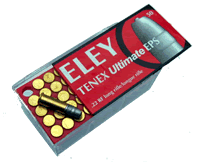
It should be mentioned that this cartridge is all well and good for the deliberate target shooter using a single-shot rifle,
but shooters of repeating and semi-automatic firearms will appreciate the feed problems that can be experienced with flat-nosed bullets.
Eley recognise this, and still produce the traditional round-nosed ammunition required by such equipment.
Indeed they also manufacture low-velocity rounds for "indoor" use
(which is not intended to convey the same meaning as for a covered range, where full-load .22RF ammunition is usually acceptable).
We continue with a representative (but far from comprehensive) listing of miniature-calibre cartridges, many of which have been used throughout the British Commonwealth and within the U.K. since before the turn of the 19th., and through much of the 20th. Centuries. We have added a few other significant British projectiles and cartridges to afford an opportunity of comparison with the miniature calibres.
Below: the line-up

and the identification - close to actual size
..............1 ................. Bulleted Breech Cap - 20 grain round-nosed bullet
..............2 ................. Bulleted Breech Cap - 20 grain conical bullet
..............3 ................. Short Rifle - copper case, 29 grain copper plated bullet
..............4 ................. Short Rifle - plated case, 29 grain plain round-nosed bullet
..............5 ................. Short Rifle - copper case, 29 grain plain round-nosed bullet
..............6 ................. Short Rifle - brass case, 29 grain plain round-nosed bullet
..............7 ................. Long - copper case, 29 grain plain (short) bullet
..............8 ................. Long Rifle - copper case, 40 grain round-nosed bullet
..............9 ................. Long Rifle - plated case, 40 grain hollow-pointed sporting bullet
..............10 .............. Long Rifle - plated case, 40 grain round-nosed bullet
..............11 .............. Long Rifle - brass case, 40 grain round-nosed bullet - Eley Club or Match
..............12 .............. Long Rifle - brass case, 40 grain flat-nosed bullet - Eley current Tenex
..............12a ........... Extra Long - copper case, 40 grain round-nosed bullet
..............13 .............. Winchester Rimfire - 37/40 grain tapered ogive flat-nosed bullet
..............14 .............. Winchester Magnum Rimfire - 40 grain jacketed soft nosed bullet
..............15 .............. French Flobert 6mm - two component case - approx. 35 grain bullet
The above are but a small proportion of the many rimfire cartridges
that have been made in .22 calibre alone. Equivalent cartridges have been
manufactured up to the American Civil War Spencer rifle's .56 inch calibre.
There have also been many in-between calibres produced in the U.S.A.,,
mainly for sporting purposes, but these are beyond the remit of this necessarily
rather general page and are, in any case, more than adequately covered
in detail by such tomes as "Cartridges of the World" (see Bibliography).
Back with the "Twenty-two", the market has not been solely for the solid-bulleted cartridge; blank-firing and shot-shells have also been produced - the former for starting pistols and target launchers, and the latter for small vermin control.
..............16................. Paper cased shot-cartridge with copper head
..............17.............. Brass-cased necked shot-cartridge
..............18.............. Copper-cased necked shot-cartridge
..............19.............. Brass-cased blank cartridge for Webley Target Launcher (Empty drinks cans)
..............20.............. Copper-cased blank cartridge for use with Webley Target Launcher.
..............21.............. Copper-cased blank cartridge for use with 'junior' starting pistols
Below are some cartridges of larger calibre, but still technically of "Miniature calibre".
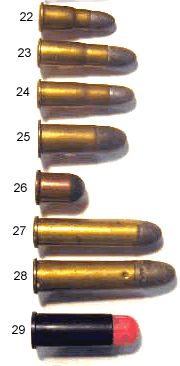 ..............22................. .297/230" Morris Short - 40 grain bullet - Centre-Fire - training
..............22................. .297/230" Morris Short - 40 grain bullet - Centre-Fire - training
..............23................. .297/230" Morris Long - 40 grain bullet - Centre-Fire - training
..............24 ................. .297/250" Rook - 80-90 grain round nosed bullet - Centre-Fire - sporting
..............25 ................. .303" - rare rimfire cartridge for the Kynoch Lee-Enfield adapter unit
..............26 .................9 mm Copper-cased Bulleted-Breech type - Rimfire
..............27 ................. .300" Rook Rifle - 80-90 (Sherwood 140-150) grain round nosed bullet - Centre-Fire - sporting
..............28 ................. .310" Cadet Rifle - 110-120 grain round nosed bullet - Centre-Fire - training
..............29 ................. .357" - .380" unusual Police Paint-ball current pistol training round
Below, five significant projectiles and cartridges for size and type comparison.

..............30 ........ nominal .75 inch calibre Brown Bess musket ball - 1790 to 1850
..............31......... .577" inch calibre Enfield Pattern 1853 Rifled musket
..............32 ..........577" inch "Snider" breech-loading conversion of above - ca 1867
..............33 ........ .577/.450 calibre Martini Henry - rolled brass case - ca 1871
..............34 ........ .303 inch British Lee-Enfield - dummy training round - ca 1888 to 1957
From here on we illustrate and discuss some cartridge production of the last Century.
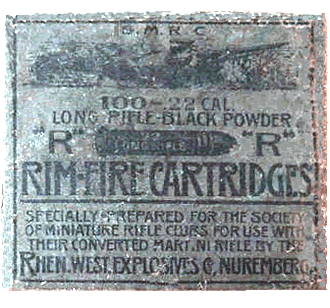 One
of the Twentieth Century's earliest offerings of Long Rifle .22RF ammunition
must be
One
of the Twentieth Century's earliest offerings of Long Rifle .22RF ammunition
must be
that manufactured by Rhen. West. Explosives Co. of Nuremberg.
This black-powder powered cartridge was bought-in
and marketed by the Society of Miniature Rifle Clubs,
probably during its first decade of existence.
The Label on the box lid declares the ammunition to be " specially prepared for the SMRC
for use with their converted Martini-Henry rifles".
Both the British NRA and the SMRC organised the buying-in, for sale to members,
of .22RF conversions of retired-from-service Martini-Henry and Martini-Enfield rifles
engineered by a number of gunsmithing companies,
those conversions of the "Martini" by W.W. Greener certainly being at the fore-front of such production.
A contemporary piece covering the subject of miniature-calibre cartridges
was written by the aforementioned gunsmith,
it is well worth taking the time to read it - " Greener on Ammunition ".
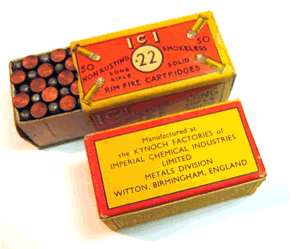
Right, are shown two complete boxes of 50 rounds of copper-cased Long Rifle ammunition
from ICI's Kynoch factory in Witton, Birmingham.
These are as first marketed during the 1920s and again post-war in 1947, right through until the late Fifties.
These cartridges sold under the "smokeless" banner from their introduction,
and only a short while later as "non-rusting", since the introduction of smokeless powders
preceded that of non-corrosive priming compounds, the latter being largely responsible for
the rapid erosion of rifle chambers and rifling leeds and the corrosion of poorly maintained barrel bores.
By the mid Twenties, very few cartridges remained that used black powder (gunpowder) as their propellant.
Semi-smokeless powders were still in use, but more for shooting out-of-doors,
and the new virtually smokeless powders were coming to the fore.
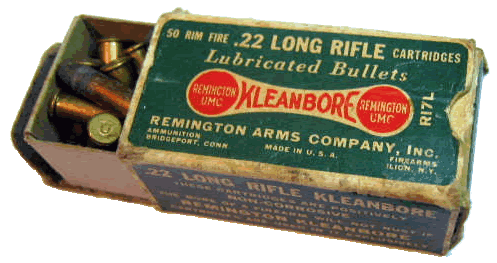 Contemporarily
to the above cartridges, by the early 1930s, and imported from the U.S.,
Contemporarily
to the above cartridges, by the early 1930s, and imported from the U.S.,
the appropriately named "Kleenbore" ammunition became available
from the Remington Arms Company (left).
By this time, the first non-corrosive primers were developed,
obviating the hitherto premature destruction of the rifling in front of the barrel's cartridge chamber.
Additionally, with the early priming compounds -
- which used ground-glass within fulminate of mercury as a medium to assist detonation -
- if Short cartridges were regularly fired from rifles chambered for the Long or Long Rifle ammunition,
then the forward section of the chamber also suffered serious erosion.
Once this had occurred, and the longer case cartridges were again used in that rifle,
the obduration of the case (i.e. the sealing of the breech from rearwards escape of pressure,
and of combustion gases, by the expansion of the annealed cartridge-case
against the walls of the chamber) would expand the case into the eroded chamber
and render extraction of the fired case problematic if not impossible.
Below: are advertisements, for .22 ammunition and accessories, taken from a 1925 catalogue.
........................
The early model of the "Quickloader" advertised above right can be viewed on a Mk.I Vickers Martini target rifle


Left and right; two boxes of ICI "Rifle Club"
The left being a wartime club issue,
and the right probably post-war,
and shown as "Mark 2"
Although .22RF ammunition was still available to clubs and advertised for sale in 1940,
its production and distribution were controlled by the Government and War Office later in the War.
Fresh supplies did not properly become available until late in 1946,
and advertisments were again placed in the shooting catalogues for 1947.
In the War years, special provision was made for those whose use of rimfire ammunition was necessary.
Vermin control, as important as ever, required some production,
but rifle training in one form or another was the critical need, either civilian or military based,
respectively within accredited clubs and associations,
the LDV ( Land Defence Volunteers - latterly the Home Guard) or territorial and regular military units.
The .22RF round was even employed by SOE (the Special Operations Executive)
and other organisations for actual and proposed clandestine work,
including such possibilities as guerilla operations in the event of invasion by the Axis forces.
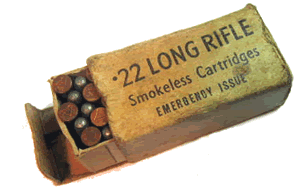
..............................................Right, is a box of " Emergency Issue" ammunition.
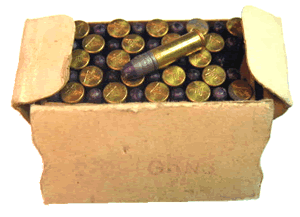 Left,
is a non-commercial box of ICI cartridges of standard appearance,
Left,
is a non-commercial box of ICI cartridges of standard appearance,
but with a purple marking on the nose of the bullet.
Possibly World War Two ( 1939-45) military issue.
The box carries only the faint purple ink stamp on the lid,
seemingly "2-09 GRNS" ( or perhaps GRN3 or GRN8).
We would welcome any certain identification of the coding.
We have [Feb' 2009] received the following from the recently retired
Keeper of Weapons at the Imperial War Museum, to who whom our thanks.
"I recently saw a letter from ICI Metals Ltd. to Westley Richards & Co., dated 29th August 1940, which stated, inter alia:
‘Regarding .22 rimfire cartridges, the Ministry of Supply has requisitioned our entire output
and has left us with only sufficient of these cartridges to meet orders for cattle killing purposes.
Certain stocks of emergency issue cartridges are still available, and so long as these last,
priority release will be granted for agricultural purposes only.
Kindly submit your requisitions, stating the name or names of your customers,
the quantity each has ordered and the purpose for which the cartridges are wanted.’
I hope that this is of interest." [Indeed it is: Ed]
Below is shown a box of 100 ICI 1940 Mark 1 wartime cartridges.
Military ammunition was issued In precisely this format until at least 1950.
Even a red-tipped tracer round was made available. This box is from 1950.
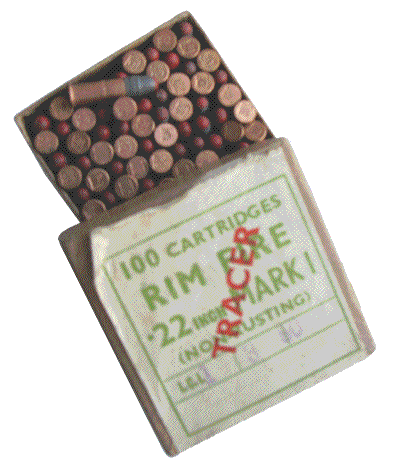
The box format remained right through until at least the early 1980s,
although the ink colour had been changed to red to denote the Mark 2 ammunition with brass cartridge cases.
These two types of ammunition, and their containing boxes, will be familiar to the many generations of young men,
and latterly women, who became members of the Combined Cadet Forces throughout Great Britain since the War.
Now in the Twenty-first Century, simply handling a box can be a nostalgic experience,
bringing back wonderful memories of companionable and character-building times.
I doubt that much has changed since the writer opened his first green printed box,
and I am sure that today's Cadet enjoys effectively the same experiences,
and will undergo the same nostalgia in years to come - political correctness permitting and common-sense prevailing.
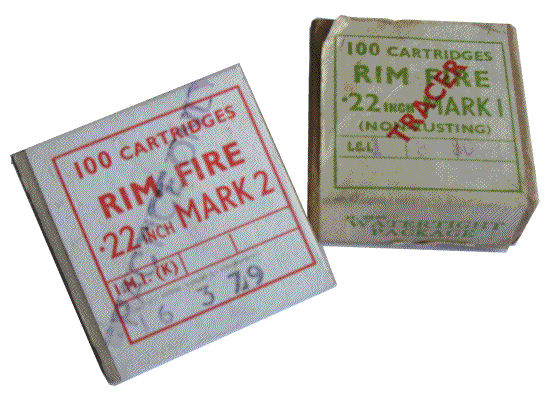
We now
leave the "Twenty-two" and drop back in time to earlier training
ammunition, 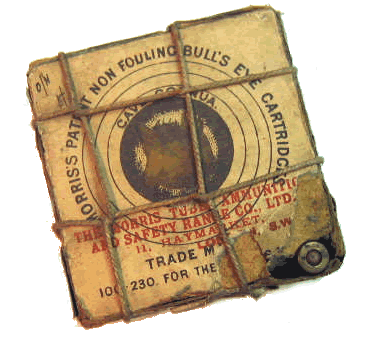
such as the Morris Ammunition Company's product.
Already illustrated individually, these cartridges were manufactured in two sizes, the Morris in the now familar and suitably descriptive guises of "Short" and "Long".
Right, is an early box of 100 of the more common Short cartridges near actual size.
The company's then trading name was "The Morris Ammunition Company and Safety Range Co.,
and the address of their offices at No.11, the Haymarket, London, is plain to see;
as is the centre-fire primer on the cartridge head.
Note that there is no head stamp, the marks are only indicators of the age
of the cartridge left by oxidation; a 'patina' would be a suitable way of describing this!
Details of the Morris aiming-tube adapter, with which these rounds could be fired
through various models of Martini and Lee-Enfield Service rifles,
are to be found on the page for Miniature Calibre adapters and conversions.
_________________________
A comprehensive illustrated article on cartridge manufacture written in 1916
affords great detail of the processes, including for rimfire ammunition,
much of which has little changed over the intervening years.
This can be viewed as a text-searchable flip-page document
or with vertical scrolling by clicking the portrait icon.
With the number of pages it may take a few moments to load.
Double tap tablet or click ![]() for full page display.
for full page display.
* "Rimfire Rifleman" Edwards Brown Jr. - 1947; see Bibliography
See also an excerpt on Miniature Rifle Ammunition - Military specification .22-inch Mk.1 (from the Textbook of Smallarms 1929)
and other contemporary writings on Miniature Rifle Shooting
Return to: TOP of PAGE
See this website's Raison d'être